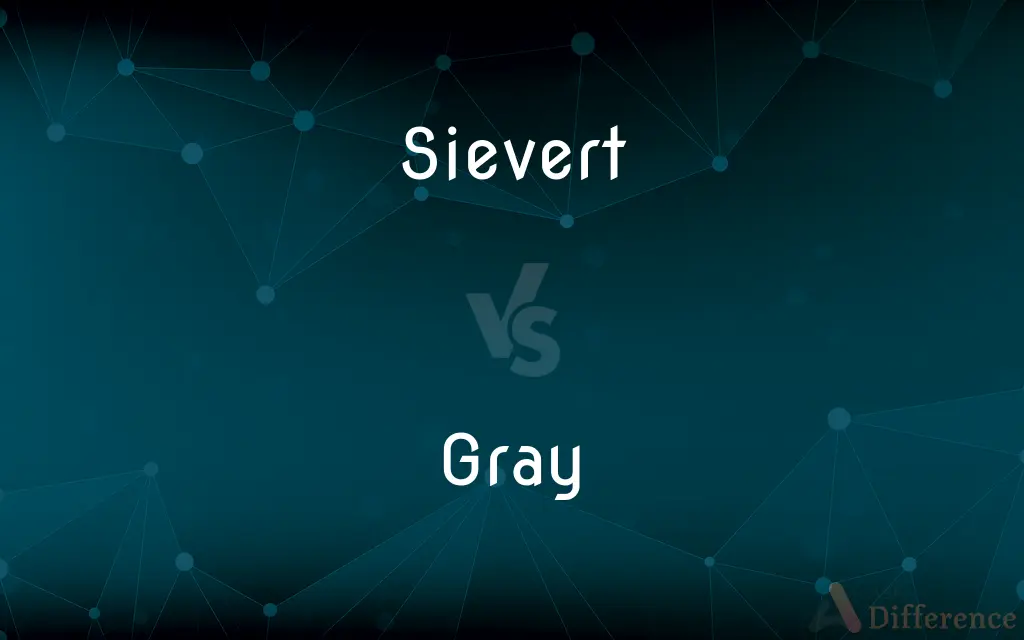Sievert vs. Gray — What's the Difference?
Edited by Tayyaba Rehman — By Fiza Rafique — Updated on March 26, 2024
Sievert measures radiation dose effect on human tissue, while Gray quantifies absorbed radiation energy.

Difference Between Sievert and Gray
Table of Contents
ADVERTISEMENT
Key Differences
Sievert (Sv) is a unit used to measure the health effect of ionizing radiation on the human body, considering the type of radiation and its energy. Whereas, Gray (Gy) is a unit that measures the absorbed dose of radiation energy by any material, without accounting for the biological effects.
The Sievert takes into account the biological effectiveness of the radiation, assigning a weighting factor to different types of radiation, reflecting their potential to cause harm. On the other hand, the Gray is purely a physical unit, measuring the energy deposited in a material per unit mass, without differentiation by radiation type.
While the Sievert is crucial in fields like radiology, radiation therapy, and radioprotection for assessing exposure risks and planning treatment, the Gray is often used in radiation processing, engineering, and physics to quantify the amount of radiation absorbed by materials.
The conversion between Sieverts and Grays involves the radiation weighting factor, which varies with the type of radiation (e.g., alpha particles, beta particles, gamma rays). This means that one Gray of one radiation type can result in a different Sievert value than one Gray of another type.
Understanding the difference between these units is essential for properly assessing radiation exposure risks and effects. The Sievert helps in evaluating the risk to human health and safety, focusing on exposure scenarios, while the Gray is more concerned with the physical aspects of radiation absorption.
ADVERTISEMENT
Comparison Chart
Definition
Measures the health effect of ionizing radiation on humans.
Measures the absorbed dose of radiation energy by materials.
Focus
Biological effect.
Physical energy absorption.
Units of Measure
Joules per kilogram (J/kg), with biological weighting.
Joules per kilogram (J/kg), purely physical.
Use Case
Assessing risk and planning in medicine and protection.
Quantifying radiation in materials and engineering.
Dependency
Type and energy of radiation.
Only the amount of absorbed energy.
Compare with Definitions
Sievert
Considers Radiation Type and Energy.
A dose of 1 Sv from alpha particles is considered more harmful than 1 Sv from gamma rays.
Gray
Unit of Absorbed Radiation.
In radiation therapy, a tumor might be targeted with a dose of 60 Gy.
Sievert
Unit of Radiation Dose Effect.
Medical professionals use Sieverts to assess the risk of radiation therapy.
Gray
Applied in Engineering and Physics.
Material testing might involve exposure to specific Gray levels to observe effects.
Sievert
Used in Radiation Protection.
Safety protocols limit worker exposure to a few milliSieverts per year.
Gray
Critical in Radiation Processing.
Food irradiation processes are specified in terms of Grays to ensure safety.
Sievert
Helps in Biological Risk Assessment.
Sieverts help in evaluating the potential for radiation-induced cancer.
Gray
Physical Measurement.
Grays measure the energy absorbed by any material, regardless of type.
Sievert
Varies by Biological Effectiveness.
Different weighting factors in Sieverts reflect varied risks from different radiations.
Gray
Does Not Account for Biological Effect.
A Gray does not indicate how harmful the radiation is to human tissue.
Sievert
The sievert (symbol: Sv) is a derived unit of ionizing radiation dose in the International System of Units (SI) and is a measure of the health effect of low levels of ionizing radiation on the human body. The sievert is important in dosimetry and radiation protection, and is named after Rolf Maximilian Sievert, a Swedish medical physicist renowned for work on radiation dose measurement and research into the biological effects of radiation.
Gray
US spelling of grey
Sievert
The SI unit for the amount of ionizing radiation required to produce the same biological effect as one rad of high-penetration x-rays, equivalent to a gray for x-rays.
Gray
The SI unit of the absorbed dose of ionizing radiation, corresponding to one joule per kilogram.
Sievert
In the International System of Units, the derived unit of radiation dose; the dose received in one hour at a distance of 1 cm from a point source of 1 mg of radium in a 0.5 mm thick platinum enclosure. Symbol: Sv
Gray
Of or relating to an achromatic color of any lightness between the extremes of black and white.
Gray
Dull or dark
A gray, rainy afternoon.
Gray
Lacking in cheer; gloomy
A gray mood.
Gray
Having gray hair; hoary.
Gray
Old or venerable.
Gray
Intermediate in character or position, as with regard to a subjective matter
The gray area between their differing opinions on the film's morality.
Gray
An achromatic color of any lightness between the extremes of black and white.
Gray
An object or animal of the color gray.
Gray
A member of the Confederate Army in the Civil War.
Gray
The Confederate Army.
Gray
The SI unit for the energy absorbed from ionizing radiation, equal to one joule per kilogram.
Gray
To make gray.
Gray
To become gray.
Gray
To become old; age.
Gray
To include a large or increasing proportion of older people
"Federal food programs can't keep up with the nation's rapidly graying population" (Michael J. McCarthy).
Gray
Having a color somewhere between white and black, as the ash of an ember.
Gray
Dreary, gloomy.
Gray
Having an indistinct, disputed or uncertain quality.
Gray
Gray-haired.
Gray
Old.
Gray
Relating to older people.
The gray dollar, i.e. the purchasing power of the elderly
Gray
To become gray.
My hair is beginning to gray.
Gray
To cause to become gray.
Gray
To turn progressively older, alluding to graying of hair through aging (used in context of the population of a geographic region)
The graying of America
Gray
To give a soft effect to (a photograph) by covering the negative while printing with a ground-glass plate.
Gray
An achromatic colour intermediate between black and white.
Gray
An animal or thing of grey colour, such as a horse, badger, or salmon.
Gray
An extraterrestrial humanoid with grayish skin, bulbous black eyes, and an enlarged head.
Gray
A penny with a tail on both sides, used for cheating.
Gray
In the International System of Units, the derived unit of absorbed dose of radiation (radiation absorbed by a patient); one joule of energy absorbed per kilogram of the patient's mass. Symbol: Gy
Gray
Any color of neutral hue between white and black; white mixed with black, as the color of pepper and salt, or of ashes, or of hair whitened by age; sometimes, a dark mixed color; as, the soft gray eye of a dove.
These gray and dun colors may be also produced by mixing whites and blacks.
Gray
Gray-haired; gray-headed; of a gray color; hoary.
Gray
Old; mature; as, gray experience.
Gray
Gloomy; dismal.
Gray
A gray color; any mixture of white and black; also, a neutral or whitish tint.
Gray
An animal or thing of gray color, as a horse, a badger, or a kind of salmon.
Woe worth the chase, woe worth the day.That coats thy life, my gallant gray.
Gray
The Confederate army or a soldier in the confederate army; as, a battle between the blue and the gray.
Gray
The SI unit of absorbed dosage of ionizing radiation, equal to an absorbed energy of 1 joule per kilogram of irradiated material; - abbreviated Gy. This unit is 100 times the commonly used unit, the rad.
Gray
A neutral achromatic color midway between white and black
Gray
Gray clothing;
He was dressed in gray
Gray
Any organization or party whose uniforms or badges are gray;
The Confederate army was a vast gray
Gray
Horse of a light grey or whitish color
Gray
English poet best known for his elegy written in a country church-yard (1716-1771)
Gray
American navigator who twice circumnavigated the globe and who discovered the Columbia River (1755-1806)
Gray
United States botanist who specialized in North American flora and who was an early supporter of Darwin's theories of evolution (1810-1888)
Gray
Make gray;
The painter decided to grey the sky
Gray
Turn gray;
Her hair began to gray
Gray
An achromatic color of any lightness between the extremes of black and white;
Gray flannel suit
Hair just turning gray
Gray
Showing characteristics of age, especially having gray or white hair;
Whose beard with age is hoar
Nodded his hoary head
Gray
Darkened with overcast;
A dark day
A dull sky
A gray rainy afternoon
Gray clouds
The sky was leaden and thick
Gray
Used to signify the Confederate forces in the Civil War (who wore gray uniforms);
A stalwart gray figure
Gray
Intermediate in character or position;
A gray area between clearly legal and strictly illegal
Common Curiosities
What does Gray measure?
Gray is a unit that measures the absorbed dose of radiation energy by any material, purely based on physical absorption without biological considerations.
Where is Gray used?
In radiation processing, engineering, and physics to quantify radiation absorption in materials.
How does the type of radiation affect Sievert calculations?
Different radiation types have different weighting factors in Sievert calculations, reflecting their potential to cause biological damage.
How are Sieverts and Grays related?
Both measure radiation, but Sieverts consider biological effects and Grays measure physical energy absorption.
Why are Sieverts important in medicine?
They help assess the risk and plan safe radiation therapy treatments, considering the potential harm to human tissues.
How are Sieverts used in radiation protection?
They are used to set exposure limits for workers and the public to minimize health risks.
What is a Sievert?
A Sievert is a unit that measures the health effect of ionizing radiation on human tissue, taking into account the type and energy of radiation.
Can Grays be converted to Sieverts?
Yes, through the application of radiation weighting factors that account for the type of radiation.
Is one unit more harmful than the other?
The terms themselves are not about harm, but a higher Sievert value indicates a higher potential for biological harm.
What roles do Sv and Gy play in radiation safety?
Sv is used for evaluating and limiting human exposure to radiation, while Gy is used in material testing and radiation processing protocols.
What is the difference in focus between Sv and Gy?
Sieverts focus on biological effects, while Grays on physical energy absorbed.
Why might a radiation therapist need to know both Sv and Gy?
They need to know Gy for the precise delivery of energy to a tumor and Sv for assessing the risk to the patient.
What does a high Gray level indicate?
It indicates a high level of energy absorption by a material, which can be critical in applications like radiation therapy.
Why are different weighting factors used in Sv calculations?
Because different types of radiation have varying levels of biological harm, requiring adjustments in assessing overall risk to human health.
Can the same amount of radiation have different Sv and Gy values?
Yes, because Sv incorporates biological effectiveness, while Gy is a measure of energy absorbed without considering biological effects.
Share Your Discovery

Previous Comparison
Fervor vs. Zeal
Next Comparison
Peripubescent vs. PubescentAuthor Spotlight
Written by
Fiza RafiqueFiza Rafique is a skilled content writer at AskDifference.com, where she meticulously refines and enhances written pieces. Drawing from her vast editorial expertise, Fiza ensures clarity, accuracy, and precision in every article. Passionate about language, she continually seeks to elevate the quality of content for readers worldwide.
Edited by
Tayyaba RehmanTayyaba Rehman is a distinguished writer, currently serving as a primary contributor to askdifference.com. As a researcher in semantics and etymology, Tayyaba's passion for the complexity of languages and their distinctions has found a perfect home on the platform. Tayyaba delves into the intricacies of language, distinguishing between commonly confused words and phrases, thereby providing clarity for readers worldwide.















































